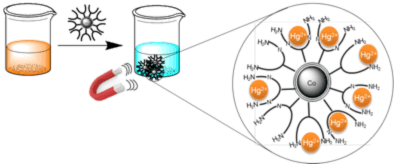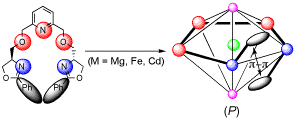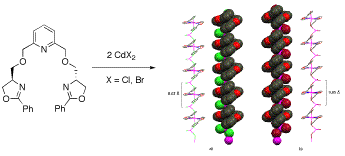 UR Home
UR Home
Coordination Chemistry
Reversible Magnetic Mercury Extraction from Water
S. Fernandes, C. M. Eichenseer, P. Kreitmeier, J. Rewitzer, V. Zlateski, R. N. Grass, W. J. Stark, O. Reiser, RSC Adv. 2015, 5, 46430-46436
Web edition: http://dx.doi.org/10.1039/C5RA04348D

Magnetic carbon-coated cobalt nanoparticles functionalized with polyethyleneimine proved to be highly effective and selective for the detoxification of mercury ions from aqueous solutions.
Enantiomerically pure pentagonal-bipyramidal metal complexes with predetermined helicity in the solid and the solution state.
M. Seitz, A. Kaiser, S. Stempfhuber, M. Zabel, O. Reiser, Inorg. Chem. 2005, 44, 4630-4636
Web edition: http://dx.doi.org/10.1021/ic050014b

New metal complexes with pentagonal-bipyramidal geometry have been synthesized with the chiral, pentadentate bisoxazoline ligand (R,R)-1, including the metal ions magnesium(II), iron(II) and cadmium(II).
Helical Chirality in Pentacoordinate Zinc Complexes - Selective Access to Both Pseudoenantiomers with One Ligand Configuration
M. Seitz, S. Stempfhuber, M. Zabel, M. Schütz, O. Reiser, Angew. Chem. 2005, 117, 246-249; Angew. Chem. Int. Ed. 2005, 44, 242-245
Web edition: http://dx.doi.org/10.1002/anie.200460843

Δ2 or Λ2, this is here the question! Depending on the heteroatom X the pentadentate bis(oxazoline) ligand will fold around a zinc(II) ion exclusively in the Δ2- or Λ2-configuration, both, in solution as well as in the solid state.
Helical, non-racemic inorganic-organic hybrid polymers of cadmium halides with pentadentate bis(oxazoline) ligands
M. Seitz, A. Kaiser, S. Stempfhuber, M. Zabel, O. Reiser, J. Am. Chem. Soc. 2004, 126, 11426-11427
Web edition: http://dx.doi.org/10.1021/ja0469784

A chiral, nonracemic pentadentate pyridine bis(oxazoline) ligand forms unprecedented P-helical inorganic organic hybrid polymers with cadmium halides. The one-dimensional chains consist of Λ2-configured pentagonal-bipyramidal cadmium complexes with metal-centered chirality bridged by [CdX4]2- tetrahedra via shared halide atoms. In the solid state, the overalll helicity exhibits strongly directed orientation parallel to the crystallographic axis a.
Predetermined helical chirality in octahedral complexes with a novel pentadentate C2-symmetric chiral bis(oxazoline) ligand
M. Seitz, A. Kaiser, D.R. Powell, A.S. Borovik, O. Reiser, Adv. Synth. Catal. 2004, 346, 737-741
Web edition: http://dx.doi.org/10.1002/adsc.200404020

The first example of new pentadentate bis(oxazolines) has been synthesized using a modular approach that readily provides access to this ligand class. This ligand allows the controlled transfer of carbon-centered to octahedral, metal-centered chirality, as demonstrated both, in the solid state as well as in solution. The characteristic CD-band has been identified for dicationic, octahedral transition-metal complexes with Δ2-configuration.



